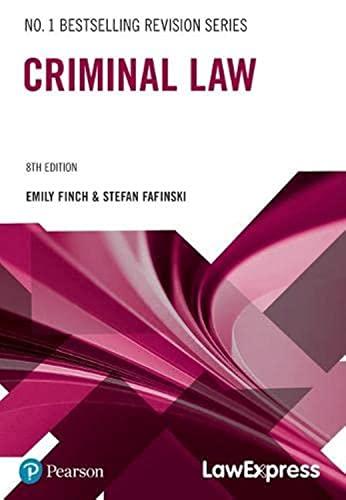Question
Questions What classification of patent is involved in this decision? Did eBay win on the issue before the Supreme Court? Explain. Summarize the position set
Questions
- What classification of patent is involved in this decision?
- Did eBay win on the issue before the Supreme Court? Explain.
- Summarize the position set forth in Justice Kennedy's concurring opinion.
Ebay, Inc. v. MercExchange, LLC, 547 U.S. 388 (2006)
eBay and its subsidiary half.com operate popular Internet Web sites that allow private sellers to list goods they wish to sell at either an auction or a fixed price (its "Buy it Now" feature). MercExchange, LLC, sought to license its business-method patent to eBay, but no agreement was reached. In MercExchange's subsequent patent infringement suit, a jury found that its patent was valid, that eBay had infringed the patent, and $29.5 million in damages were appropriate. However, the District Court denied MercExchange's motion for permanent injunctions against patent infringement absent exceptional circumstances. MercExchange appealed. The Federal Circuit Court of Appeals reversed, and the U.S. Supreme Court grantedcertiorari.
Judicial Opinion
THOMAS, J.... According to well-established principles of equity, a plaintiff seeking a permanent injunction must satisfy a four-factor test before a court may grant such relief. A plaintiff must demonstrate: (1) that it has suffered an irreparable injury; (2) that remedies available at law, such as monetary damages, are inadequate to compensate for that injury; (3) that, considering the balance of hardships between the plaintiff and defendant, a remedy in equity is warranted; and (4) that the public interest would not be disserved by a permanent injunction.... The decision to grant or deny permanent injunctive relief is an act of equitable discretion by the district court, reviewable on appeal for abuse of discretion.
These familiar principles apply with equal force to disputes arising under the Patent Act.... To be sure, the Patent Act also declares that "patents shall have the attributes of personal property," 261, including "the right to exclude others from making, using, offering for sale, or selling the invention," 154(a)(1). According to the Court of Appeals, this statutory right to exclude alone justifies its general rule in favor of permanent injunctive relief. But the creation of a right is distinct from the provision of remedies for violations of that right. Indeed, the Patent Act itself indicates that patents shall have the attributes of personal property "[s]ubject to the provisions of this title," 35 U.S.C. 261, including, presumably, the provision that injunctive relief "may" issue only "in accordance with the principles of equity," 283....
Because we conclude that neither court below correctly applied the traditional four-factor framework that governs the award of injunctive relief, we vacate the judgment of the Court of Appeals, so that the District Court may apply that framework in the first instance. In doing so, we take no position on whether permanent injunctive relief should or should not issue in this particular case, or indeed in any number of other disputes arising under the Patent Act....
Reversed and Remanded.
Chief Justice ROBERTS, with whom Justice SCALIA and Justice GINSBURG join, concurring. I agree with the Court's holding that "the decision whether to grant or deny injunctive relief rests within the equitable discretion of the district courts, and that such discretion must be exercised consistent with traditional principles of equity, in patent disputes no less than in other cases governed by such standards,"ante, at 1841, and I join the opinion of the Court. That opinion rightly rests on the proposition that "a major departure from the long tradition of equity practice should not be lightly implied."...
Justice KENNEDY, with whom Justice STEVENS, Justice SOUTER, and Justice BREYER join, concurring.... To the extent earlier cases establish a pattern of granting an injunction against patent infringers almost as a matter of course, this pattern simply illustrates the result of the four-factor test in the contexts then prevalent. The lesson of the historical practice, therefore, is most helpful and instructive when the circumstances of a case bear substantial parallels to litigation the courts have confronted before.
In cases now arising trial courts should bear in mind that in many instances the nature of the patent being enforced and the economic function of the patent holder present considerations quite unlike earlier cases. An industry has developed in which firms use patents not as a basis for producing and selling goods but, instead, primarily for obtaining licensing fees. See FTC, To Promote Innovation: The Proper Balance of Competition and Patent Law and Policy, ch. 3, pp. 38-39 (Oct. 2003). For these firms, an injunction, and the potentially serious sanctions arising from its violation, can be employed as a bargaining tool to charge exorbitant fees to companies that seek to buy licenses to practice the patent. When the patented invention is but a small component of the product the companies seek to produce and the threat of an injunction is employed simply for undue leverage in negotiations, legal damages may well be sufficient to compensate for the infringement and an injunction may not serve the public interest. In addition injunctive relief may have different consequences for the burgeoning number of patents over business methods, which were not of much economic and legal significance in earlier times. The potential vagueness and suspect validity of some of these patents may affect the calculus under the four-factor test....
Step by Step Solution
There are 3 Steps involved in it
Step: 1

Get Instant Access to Expert-Tailored Solutions
See step-by-step solutions with expert insights and AI powered tools for academic success
Step: 2

Step: 3

Ace Your Homework with AI
Get the answers you need in no time with our AI-driven, step-by-step assistance
Get Started


